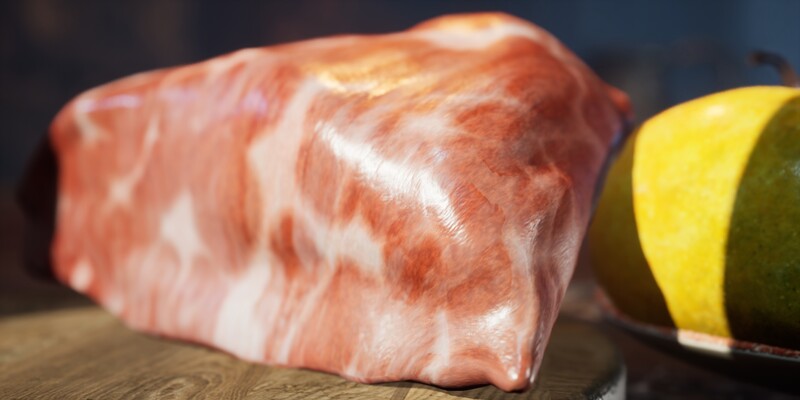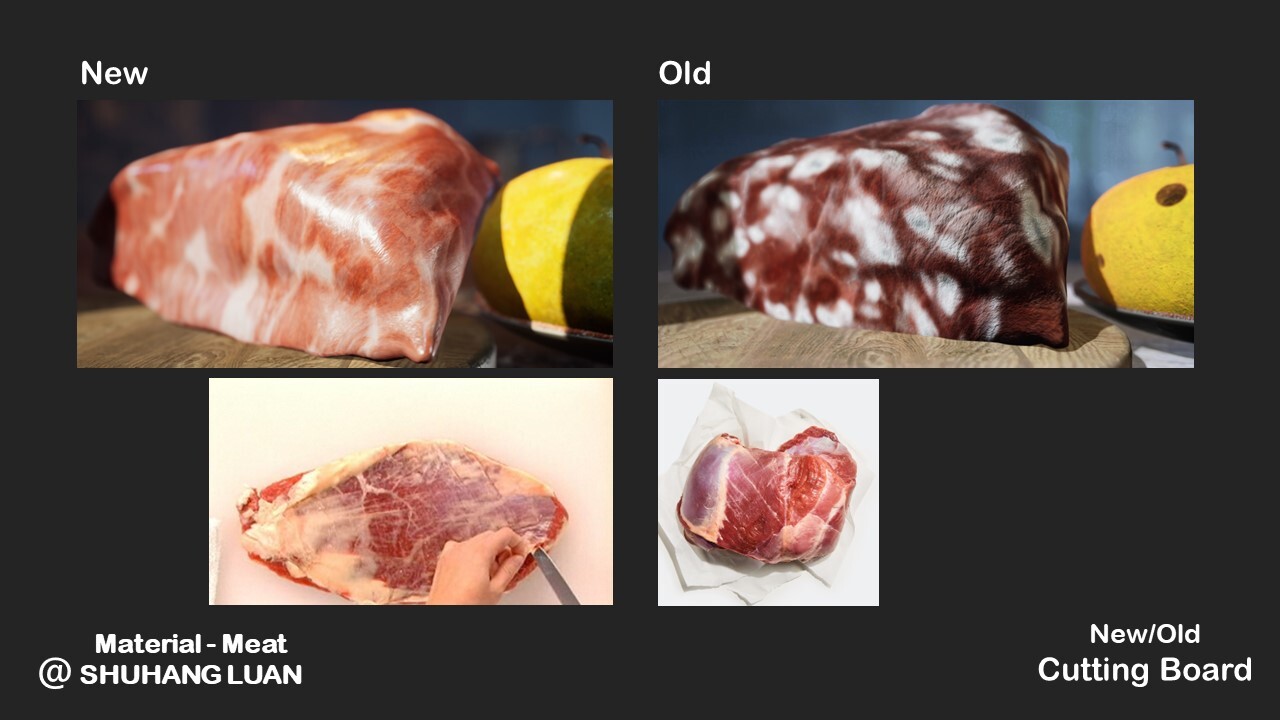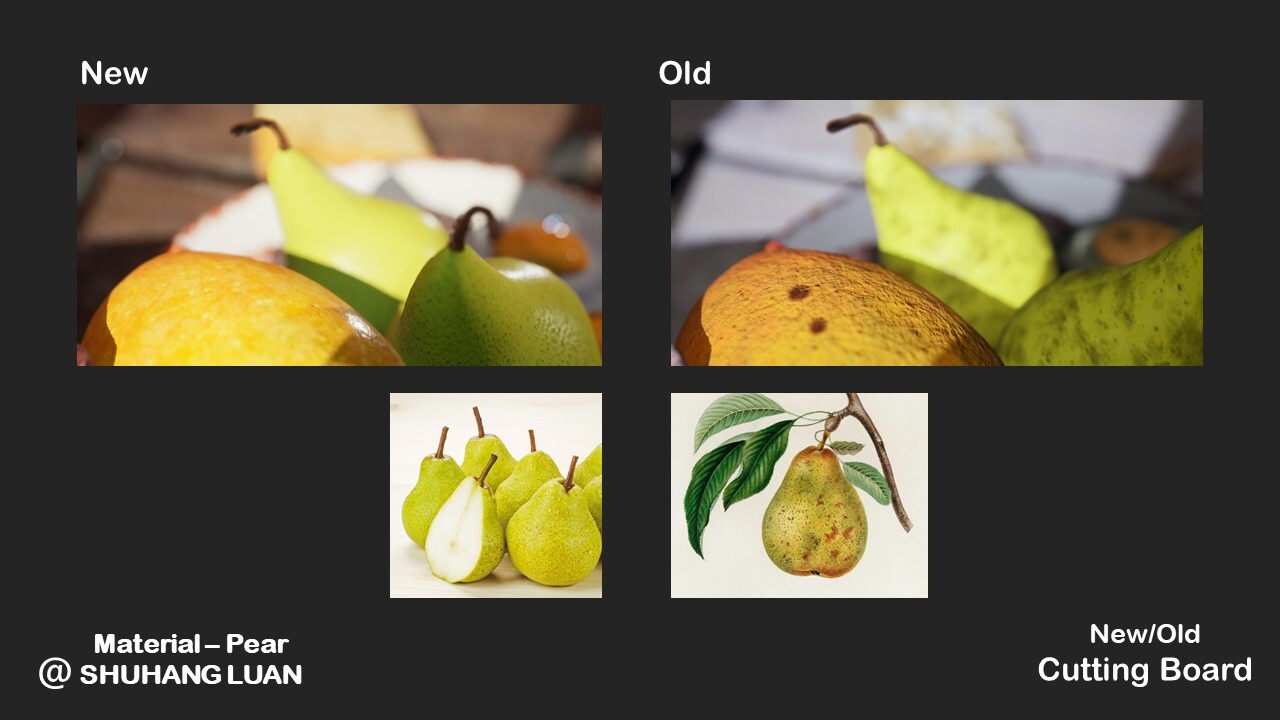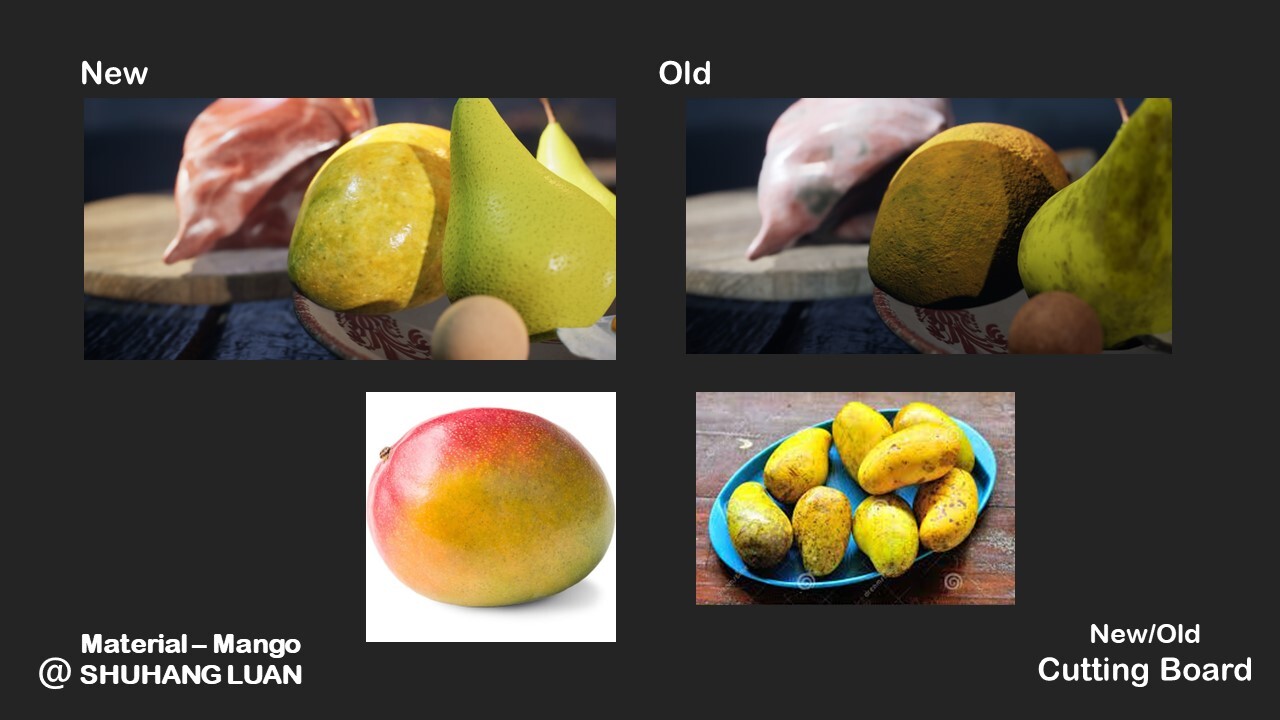
Documentation:《From Farm to Game: Implementation of Modular Material Technology in Organic Food Virtual Scenes》
From Farm to Game: Implementation of Modular Material Technology in Organic Food Virtual Scenes
1. Introduction
1.1 Research Background and Objectives
In the game development process, scene design and production have always been essential aspects. The realism and level of detail directly affect game quality and player experience. With the continuous development of technology, game scene production and rendering are constantly innovating and progressing. Modular material technology is an important approach that can decompose elements or objects in the scene into multiple smaller modules for production and assembly. Each module can be individually produced and modified, thus improving production efficiency and reducing workload.
In game scene production, organic food scenes are an important category, including various vegetables, fruits, meats, and other food-related scenarios. In organic food scene production, in addition to considering the characteristics and forms of the food itself, attention must also be given to material production and rendering.
1.2 Research Methods and Framework
This article aims to explore the application of modular material technology in the production and rendering of organic food scenes. By introducing the concept, features, and design requirements of organic food scenes, this article will explain in detail how to use modular material technology to create materials and lighting effects in organic food scenes. This includes using Maya for model production and UV unwrapping, Substance Designer for material production, and Substance Painter for texture painting and adjustment.
Based on this, specific case analysis will be used to demonstrate how to use modular material technology to create realistic organic food scenes. Then, the factors and precautions to be considered in the rendering of organic food scenes will be discussed, as well as application examples of modular material technology in organic food scene rendering. Finally, the article will provide a detailed introduction to the use of Substance Suite for organic food material production and the application of UE5 for organic food scene building, animation, and rendering, and showcase the display effects of organic food scenes.
2. Product Showcase
2.1 Final Animation
2.2 Final Screenshot

3. Modular Material Technology Application
3.1 Model Preparation (Maya)
Model Creation:
First, according to the design requirements and scene demands, create models in Maya. This includes modeling various organic food elements such as vegetables, fruits, and meats. Utilize the polygon modeling tools in Maya to create models based on actual needs and design requirements. During the modeling process, pay special attention to model details and forms to ensure the final model meets practical requirements and scene demands.
UV Unwrapping:
After completing the model creation, UV unwrapping is required. UV unwrapping is the process of unfolding the 3D model surface into a 2D image, a prerequisite for material mapping and texture painting. In the UV unfolding process, use the UV editing tools in Maya to arrange and adjust the UVs for each model. During the UV layout process, pay special attention to model continuity and repeatability to ensure the final UV texture map meets practical requirements and scene demands. Simultaneously, use the UV layout tools and automatic unwrapping tools in Maya to improve UV layout efficiency and accuracy.

3.2 Modular material technology
In the production of organic food scenes, texture mapping is crucial. To create realistic organic materials, use two professional texture production software, Substance Designer and Substance Painter. By using them, the efficiency and quality of texture map production can be effectively improved.
3.1 Material Texture Analysis
Taking a mango as an example, organic food material has complex colors and texture details. The following is an analysis of this material and how to use node painting in Substance Designer to create this material:
Color Variation and Distribution
The color variation and distribution of mangoes are very rich, typically presenting a mixture of yellow, orange, and red colors. Additionally, the surface color of the mango also has granular distribution, with these granular colors usually presenting dark or light dot-like distributions.
In Substance Designer, various nodes can be used to create complex color variations and distribution effects, such as Gradient Map and Gradient Radial. Different nodes and parameters can be chosen based on the actual situation to achieve the desired color effect. Also, Mask nodes can be used to achieve granular color distribution effects, and Noise nodes can be used to create fine noise detail effects.
Texture and Granular Details
Mango surfaces have very rich textures and granular details, which usually present characteristics such as varying depths, different sizes, and complex shapes. The texture and granules on the mango surface are typically concentrated in the concave and convex parts of the fruit, such as around the core.
In Substance Designer, various nodes can be used to create complex texture and granular detail effects, such as Noise and Height to Normal. Different nodes and parameters can be chosen based on the actual situation to achieve the desired effect. Also, Mask nodes can be used to control the distribution location and size of the textures and granules to achieve a more realistic effect.
In summary, organic food materials like mangoes have very complex colors and texture details. By using node painting in Substance Designer, realistic mango materials can be easily created. It is essential to note that different mango varieties and qualities will present different colors and texture characteristics; therefore, adjustments and optimizations should be made based on actual situations during production.

Other Food Analysis
Meat
Texture: Grilled meat surfaces have fascia, fiber texture, and fat distribution.
Color: Meat color ranges from reddish-brown to dark brown.
Spots: Grilled meat surfaces have some

Fried Egg
Texture: The surface of the fried egg has a bumpy texture formed by the coagulation of proteins, while the yolk surface has tiny granular textures.
Color: The egg white is a light yellow color, and the yolk center is a deep yellow color.
Spots: The surface of the fried egg has a small number of scorch marks produced during the cooking process.
Gradient: The yolk color gradually becomes lighter from the center outwards.

Fragrant Pear
Texture: The surface of the fragrant pear has subtle skin textures.
Color: The color of the fragrant pear varies from green to yellow, reflecting the fruit’s ripeness.
Spots: The surface of the fragrant pear has some spots and scars.
Gradient: The color of the fragrant pear gradually deepens at the top of the fruit.

Cheesecake
- Color: The main color of the cheesecake is yellow.
- Spots: The surface of the cake has holes caused by the release of carbon dioxide gas.

3.2 Modular Material Creation (Substance Designer)
Modular material technology allows for the decomposition of complex materials into multiple smaller modules for creation and combination. Each small module can be individually created and modified, improving efficiency and reducing workload. Substance Designer, a professional material creation software, can easily create a variety of complex modular materials.
Create Basic Materials
First, we need to create a basic material. In Substance Designer, basic nodes (such as Gradient Map, Checker, Turbulence, etc.) can be used to create basic materials, and then add color, glossiness, and other properties. These basic nodes can be combined with other nodes to create various different materials.
Create Material Modules
Next, we can use various nodes and tools to create material modules. Substance Designer provides a wealth of nodes and tools, such as Noise, Tile Sampler, Pattern Generator, etc., which can easily create various material details, such as textures, bumps, and particles. When creating modules, different nodes and tools can be selected according to the actual situation to achieve the desired effect.
Combine Material Modules
After creating various material modules, we need to combine them to create a complete modular material. In Substance Designer, Blend, Transform, and other nodes can be used for combination, and Functions, Switch, and other nodes can be used for control to achieve various different combination effects.
Workflow for Creating Mango Material Using Modular Texture
Taking mango as an example, we will explain how to use modular material technology to create realistic mango materials in Substance Designer. First, we can use basic nodes to create a basic material and add color, glossiness, and other properties. For organic food materials like mangoes, Noise, Tile Sampler, Pattern Generator, and other nodes and tools can be used to create various material details, such as the texture and graininess of the flesh, and the glossiness and bumps of the skin. When creating modules, different nodes and tools should be selected according to the actual situation to achieve the desired effect.
After creating various material modules, they need to be combined to create a complete mango material. In Substance Designer, Blend, Transform, and other nodes can be used for combination, and Functions, Switch, and other nodes can be used for control to achieve various different combination effects. It is important to note that different mango varieties and qualities will present different colors and texture characteristics, so adjustments and optimizations should be made according to the actual situation during production. By using modular material technology, the efficiency and workload of creating mango materials can be improved.


Meat:

Analysis of important nodes
- Input nodes: These nodes are used to import different input images or parameters, such as height maps and normal maps. In the case of mango material, these nodes might import the height map and normal map of a mango.
- Shape nodes: These nodes are used to create basic shapes, such as spheres or cubes. In the case of mango material, these nodes might be used to create the basic shape of a mango.
- Generator nodes: These nodes are used to generate various textures, noise patterns, and patterns. In the case of mango material, these nodes might be used to create the texture and grain effect on the surface of a mango.
- Filter nodes: These nodes are used to adjust and filter the input images or textures. In the case of mango material, these nodes might be used to adjust the color and texture of the surface of a mango.
- Blending nodes: These nodes are used to blend and combine different material modules. In the case of mango material, these nodes might be used to blend and combine different texture modules.
- Utility nodes: These nodes are used to perform practical functions such as rotation, transformation, and curve adjustment. In the case of mango material, these nodes might be used to adjust and optimize the color and texture of a mango.
- Output nodes: These nodes are used to output the final material texture. In the case of mango material, these nodes generate the final mango material texture for use in rendering.
It should be noted that these nodes are only a part of the nodes available in Substance Designer, and many other types of nodes can be used depending on the actual material production needs.
3.3 Modular Material Painting (Substance Painter)
First, we need to import the model and material into Substance Painter. When importing materials, preset materials or custom materials can be selected. At the same time, material properties such as color, glossiness, and metallicity can also be set.
Next, we can use the Paint tool to paint the basic color on the model. When painting the basic color, different color, transparency, and brush size parameters can be selected according to the actual situation to achieve the desired effect.
Add Material Details
After painting the basic color, various tools and nodes can be used to add material details. Substance Painter provides rich tools and nodes, such as brushes, generators, smart materials, etc., which can easily add various material details such as textures, bumps, particles, etc. When adding details, different tools and nodes can be selected according to the actual situation to achieve the desired effect.
In summary, modular material technology can improve production efficiency and reduce workload, and Substance Designer and Substance Painter can be used to easily create and paint various complex modular materials.
Adjusting Material Properties
We can use pre-made modular materials in Substance Designer and adjust their properties to quickly achieve different material effects. These properties can include color, texture, transparency, metallic, roughness, and other parameters, which can be adjusted according to the specific needs to achieve the desired effect. By using modular materials, we can quickly create different material effects, improve production efficiency, and significantly reduce production difficulty and cost.
By adjusting the properties of modular materials, we can quickly change the appearance and effect of the materials. For example, in mango materials, we can change the texture, bumpiness, and color of the mango by adjusting the height map, normal map, and color map properties. Additionally, we can further adjust the appearance and effect of the material by adding various filters and adjusters, such as curve adjusters, color balancers, noise filters, and others. These tools and techniques can help us quickly achieve various complex material effects, improve production efficiency and quality.

3.4 Other work images





4. Constructing and Optimizing Organic Food Scenes in Unreal Engine
Building organic food scenes requires initial scene layout and model construction. In Unreal Engine, you can use built-in basic geometries for scene layout or create more complex models in 3D modeling software (such as Maya) and import them into Unreal Engine.
4.1 Material Blueprint Creation
In Unreal Engine, Material Blueprints can be used to create more complex and advanced material effects. Material Blueprints allow us to combine multiple nodes and materials into a complete material effect. Material Blueprints provide a wealth of nodes and functions, such as Math, Texture Sample, Material Attributes, etc. We can adjust the properties of color, transparency, metallicity, roughness, and lighting by controlling their attributes and connecting different function nodes to achieve different material effects. Furthermore, Material Blueprints also support the creation of material instances, allowing us to apply various materials to different parts of the model for more detailed effects.
Taking a fried egg as an example, even if we have already fully painted PBR textures in Substance Painter, after importing into Unreal Engine, we still need to perform secondary modular editing of the material while using the textures to achieve better effects.
4.2 Create Parent Material
When creating a parent material, you can use a basic PBR material as a foundation and then add additional nodes and features as needed, such as detail texture overlays and emissive effects. The parent material will serve as the basis for material instances, so it’s important to ensure it has sufficient flexibility and extensibility.
4.3 Create Material Instances
In Unreal Engine, we can create multiple material instances for a model, with each instance being individually editable and controllable. When creating material instances, you can choose different parent materials as the basis and then adjust and customize them as needed.
For example, with a fried egg, create a Masked material with a transparency channel and add controllable variables for each texture. Then, adjust the properties of color, texture, reflectivity, etc., for the different parts of the fried egg (such as the yolk, egg white, and grease) to achieve the desired effect. At the same time, you can also set other properties for material instances, such as name, output, priority, and transparency support.



With this parent-child material structure, we can easily manage and edit complex material effects while ensuring material organization and optimization. In organic food scenes, this Material Blueprint technique can greatly improve the visual quality and realism of the scene.
In conclusion, Unreal Engine offers a wealth of material editing and construction tools that can meet various production requirements. In the creation of organic food scenes, we can achieve more realistic and detailed scene effects by flexibly utilizing these tools and techniques.

5. Lighting and Atmosphere Setup in Unreal Engine Scenes
In organic food scenes, lighting and atmosphere setup is crucial as it directly affects the player’s gaming experience. Unreal Engine comes with a built-in lighting system and post-processing features that help create realistic lighting and atmosphere effects.
5.1 Using Unreal Engine’s Built-in Lighting System
In Unreal Engine, the lighting system includes various types of lights, catering to different scenes and requirements. Here are some main light types and techniques when using Unreal Engine’s lighting system to create organic food scenes:
- Natural Light: Use Directional Light to simulate natural light sources (such as the sun), and adjust the light direction, color, and intensity to change the scene’s atmosphere.
- Nighttime Light: Nighttime lighting can be achieved by adjusting the color and intensity of the directional light and adding SkyLight and Point Light to simulate moonlight and other nighttime light sources.
- Indoor Light: Indoor lighting can be created by using Spot Light and Point Light to simulate lamps, while also adjusting light color, intensity, and shadow parameters to alter the indoor atmosphere.
5.2 Using Unreal Engine’s Built-in Post-Processing Features
In Unreal Engine, post-processing features can further optimize the visual effects of a scene. Here are some common post-processing techniques used in organic food scenes:
Tone Mapping: Tone mapping adjusts the overall color tone of a scene to match the actual environment and atmosphere. In organic food scenes, select suitable tone mapping parameters based on the scene’s theme and background, such as warm and cool tones or high saturation.
Depth of Field: Depth of field simulates real-world depth of field effects, adding depth to the image. In organic food scenes, use depth of field to highlight key areas, such as featured food or window displays. Adjust the focus distance and range to achieve varying levels of depth of field effects.

Lens Flare and Bloom: Lens flare and bloom simulate light scattering in the lens, adding realism and dynamism to the image. In organic food scenes, choose appropriate lens flare and bloom effects based on actual needs, such as simulating sunlight scattering or indoor light reflections.
5.3 Ambient Occlusion
Ambient Occlusion is a global illumination technique used to simulate self-shadowing effects on object surfaces. In organic food scenes, use ambient occlusion to enhance local details and depth. Adjust the intensity and range of ambient occlusion to achieve varying levels of self-shadowing effects.
5.4 Screen Space Reflections
Screen Space Reflections simulate reflection effects on object surfaces. In organic food scenes, use screen space reflections to enhance realism, such as generating reflections on wet fruit surfaces or glass windows. Adjust the reflection accuracy and intensity to achieve varying levels of reflection effects.
5.5 Global Illumination
Global Illumination is a realistic lighting simulation technique that considers direct lighting, indirect lighting, and multiple reflections. In organic food scenes, global illumination provides more realistic lighting effects, making the brightness and color of objects more harmonious and unified. Unreal Engine offers various global illumination techniques, such as Lightmaps and Light Probes, allowing for selection based on scene requirements.
By comprehensively using Unreal Engine’s built-in lighting system, post-processing features, ambient occlusion, screen space reflections, and global illumination techniques, a variety of atmospheres and effects can be created in organic food scenes. Furthermore, these techniques can be explored and optimized as needed to achieve even more realistic and vivid effects.
5.6 Scene screenshot






6. Conclusion
6.1 Summarize the research content of this article
This article investigates the application of modular material technology in the creation of organic food scenes. First, we introduced the concept, features, and design requirements of organic food scenes. Then, we elaborated on the use of modular material technology to create materials and lighting effects in organic food scenes, as well as how to utilize Unreal Engine for scene construction. The article also discusses factors and considerations to be taken into account when rendering organic food scenes, providing practical application examples. Lastly, we introduced the application practices of creating organic food materials using Substance Suite and building, animating, and rendering organic food scenes using Unreal Engine.
6.2 Point out the shortcomings of the research and the future development direction
Despite the achievements made in this article, there are still some shortcomings in practical applications. The following are the shortcomings of this research and the future development directions:
- The cases covered in this article are limited, only including a few organic food scenes. Future research can expand the range of cases, exploring the creation of more types of organic food scenes to meet the needs of different game genres and scene requirements.
- This article mainly focuses on the application of modular material technology in the creation of organic food scenes and does not involve other fields. Future research can investigate the application of modular material technology in other scenes and fields, such as architecture and natural environments, to further expand the scope of technology application.
- The current modular material technology still has certain limitations, such as the level of detail in texture painting and the complexity of material processing. Future research can address these issues by continuing to optimize techniques and methods to improve the efficiency and quality of material production.
- With the development of technologies like virtual reality (VR) and augmented reality (AR), future game scene creation will face higher requirements. Therefore, research should focus on the impact of these new technologies on modular material technology and how to optimize modular material technology to meet the needs of VR and AR application scenarios.
- Title: Documentation:《From Farm to Game: Implementation of Modular Material Technology in Organic Food Virtual Scenes》
- Author: Shuhang Luan
- Created at: 2023-03-13 15:53:47
- Updated at: 2023-03-19 10:36:55
- Link: https://archieluan.github.io/2023/03/13/Modular-Material-Technique/
- License: This work is licensed under CC BY-NC-SA 4.0.













